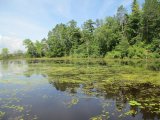EPA Research in Minnesota

EPA researchers are working hard to protect communities across the nation. Learn about some of the work EPA researchers are doing in Minnesota.
- EPA Researchers Partner with the Minnesota Department of Health to Screen for Chemicals of Health Concern in Water
- Modeling Bioaccumulation of PCBs and Mercury in Fish
- Screening and Prioritizing Chemicals to Protect Public Health
- Evaluating Risk of Aquatic Contaminants
- Water Quality Data for Stormwater Reuse
- Helping Water Systems Keep Lead Out of Drinking Water
- Preserving and Promoting the Cultural Significance of Kingsbury Bay and Grassy Point
- Linking Minnesota Land Cover Changes to Drinking Water Treatment
- Staging a Comeback Along the St. Louis River
For more EPA work, see EPA in Minnesota.
EPA Researchers Partner with the Minnesota Department of Health to Screen for Chemicals of Health Concern in Water
There are many different chemicals that are released into our environment, and the ability to characterize human exposure and risk of every one of those chemicals is limited. EPA's Office of Research and Development (ORD) partnered with the Minnesota Department of Health to develop an automated screening process to determine chemicals of greatest exposure concern for further investigation. Read EPA Researchers Partner with the Minnesota Department of Health to Screen for Chemicals of Health Concern in Water.
Modeling Bioaccumulation of PCBs and Mercury in Fish

ORD worked with Minnesota Pollution Control Agency (MPCA) staff to develop a geospatial, habitat-based model of fish bioaccumulation of polychlorinated biphenyl (PCBs) to help determine the extent of PCB contamination in the St. Louis River Great Lakes Area of Concern. The model is being used to screen for contamination “hot spots,” determine remediation targets for contamination, and develop monitoring plans for future assessments.
Screening and Prioritizing Chemicals to Protect Public Health
The Minnesota Department of Health’s (MDH) Toxic Free Kids (TFK) program identifies and communicates the potential for hazardous chemical exposures from consumer products to harm human health, particularly children and pregnant people, who can be more vulnerable. To support the program, ORD developed a software to facilitate rapid evaluations of chemicals for their potential risks to these groups. The downloadable software is being used by TFK program to review and revise the Chemicals of High Concern list every three years and prioritize chemicals for consideration for their Priority Chemical List. ORD also worked with MDH to develop an automated workflow that would enable rapid evaluation of thousands of chemicals using MDH’s criteria.
Evaluating Risk of Aquatic Contaminants
EPA ORD scientists support ongoing efforts in Minnesota to characterize potential effects for a wide variety of contaminants for which there exists limited information. MPCA uses a suite of EPA tools ‒ Estimation Programs Interface Suite, ECOTOX, Web-ICE ‒ to prioritize chemicals based on toxicity effects and hazard characterization. Using these tools, MPCA develops toxicity profiles to screen contaminants that have been detected in the state, and then uses those profiles to prioritize chemicals for further monitoring or pollution prevention opportunities.
Water Quality Data for Stormwater Reuse

There is limited data to determine the suitability of stormwater for direct reuse in surface irrigation systems, either on a commercial or residential scale. ORD, in collaboration with EPA's Region 5 and the Minnesota Department of Health, planned and implemented stormwater sampling events to determine water quality impacts on irrigation and agricultural stormwater reuse. The research provided relevant information on the extent of physical, chemical and microbial contamination of reuse waters and the effectiveness of filtration and disinfection technologies to reduce public health risks.
Helping Water Systems Keep Lead out of Drinking Water
If a water system has lead service lines, limiting corrosion is a necessary step to reduce lead exposure from drinking water. EPA and other scientists use predictive solubility models to try and help drinking water systems pick the right corrosion control treatment that fits their system’s individual needs. EPA researchers looked at how well these models were predicting what is happening in the real world by using data and real-world pieces of piping from EPA’s Region 5 — comprised of Minnesota, Wisconsin, Michigan, Illinois, Indiana, and Ohio. Read EPA Researchers Help Water Systems Keep Lead out of Drinking Water.
Preserving and Promoting the Cultural Significance of Kingsbury Bay and Grassy Point

EPA and partners are restoring sites along the St. Louis River that have long suffered from pollution. These areas have traditionally provided space for spiritual reflection and other tribal uses for the Native American communities in the area. EPA researchers worked with Fond du Lac Band members so that Tribal resources, culturally significant places, and Indigenous Knowledges are incorporated into recommendations for restoration plans. Read Helping Preserve and Promote the Cultural Significance of Kingsbury Bay and Grassy Point.
Linking Minnesota Land Cover Changes to Drinking Water Treatment
EPA scientists and partners used EnviroAtlas to model recent land cover changes in Minnesota to understand how projected changes could affect future water quality and associated treatment costs. Read Linking Minnesota Land Cover Changes to Drinking Water Treatment.
Staging a Comeback Along the St. Louis River
EPA researchers and a host of partners have been working to restore the St. Louis River estuary and help local communities reap the full benefits of a clean, healthy environment. The estuary, located at the head of Lake Superior, was designated as an 'area of concern' due to a legacy of chemical contamination, degraded habitat, and non-point-source pollution. Read Staging a Comeback Along the St. Louis River.
